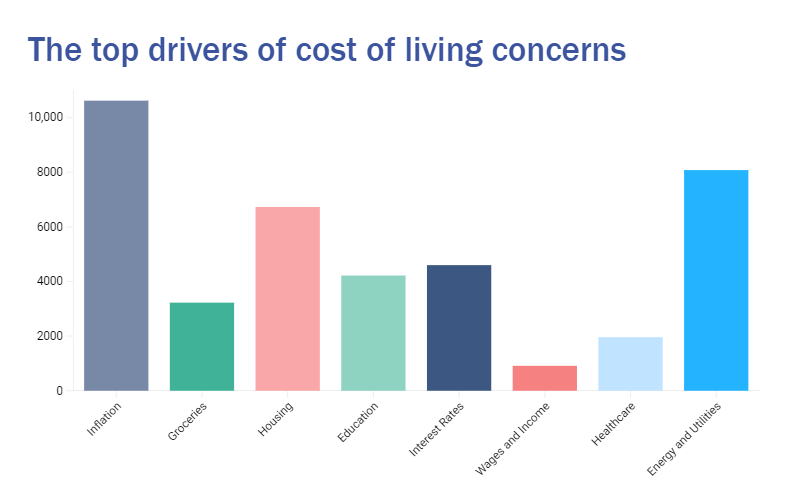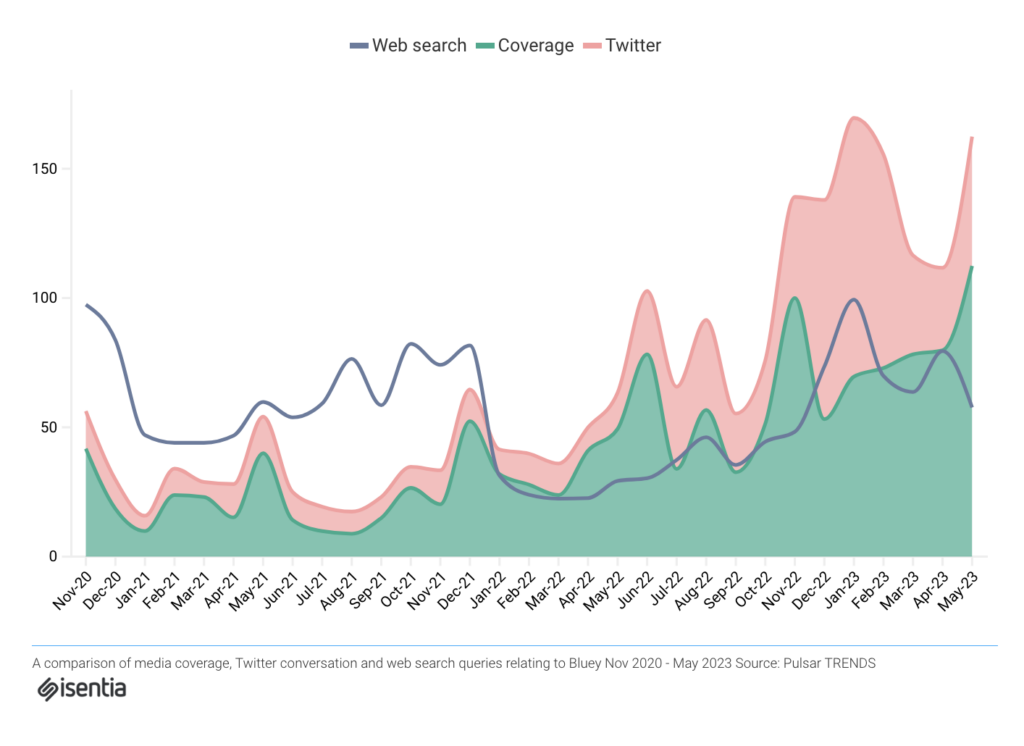The rising cost of living is not just an issue in Australia but a global concern that affects countless individuals. Within our shores, people are facing the daunting challenge of affording basic necessities while striving to maintain a decent standard...
The rising cost of living is not just an issue in Australia but a global concern that affects countless individuals, with people facing the daunting challenge of affording basic necessities while striving to maintain a decent standard of living. It’s a topic that can touch a nerve for many, but it’s also a dynamic conversation that drives the media, public opinion, and individual experiences.
What’s driving the cost of living concerns?
A range of factors are driving the cost of living in Australia, with some having more of an impact than others. Using data from our sister company, Pulsar, inflation (as the overarching issue) is gaining the most media coverage as the price of goods and services continues to increase over time.
 Source: Pulsar TRAC, 1 Jan – 30 Jun 2023
Source: Pulsar TRAC, 1 Jan – 30 Jun 2023The chart also shows the rise in energy costs, interest rates, and housing prices (rent and mortgage prices) as other main drivers for cost of living concerns. As energy prices continue to increase, households are feeling the pinch as their expenses soar. And when it comes to housing, whether it’s the skyrocketing rent or the burden of increasing mortgage payments, many individuals and families are finding it increasingly challenging to secure affordable accommodation.
Let’s take a closer look at these topics.
Energy fuels the discussion
Energy sources and prices are hot topics in the media, impacting households, affordability, and vulnerable populations. But a troubling discrepancy emerged in the May 2023 Budget: businesses got more attention than households in energy relief measures. Surprisingly, only 13% of media coverage focused on the struggles faced by individuals, while a whopping 29% centered around the politics and policies of Australian businesses. This raises valid concerns about whether the media is truly addressing the needs of Australian communities.

Sectors feeling the heat of media scrutiny
Media outlets play a crucial role in shaping public opinion and influencing the cost of living. When it comes to specific energy sectors, they have become the subject of intense media scrutiny. Data from our Energy Transition report shows that coal and gas are in the hot seat, with a significant portion of media coverage – 43% for coal and 26% for gas – dedicated to discussing these fossil fuels. This media focus highlights the ongoing conversations surrounding the environmental impact of coal and gas, their contribution to climate change, economic considerations, and the urgent need for policy changes to transition to cleaner energy sources.

Feeling the pinch
The cost of living crisis goes beyond numbers; it’s intertwined with the housing market and interest rates. Escalating housing costs, fueled by rising prices and interest rates, can put immense strain on household budgets, leading to financial stress and widening economic inequality.
But the conversation doesn’t stop there. The story behind the data is clear: the cost of living is an issue that affects us all, and the media plays a crucial role in shaping and amplifying the conversation. Google searches and social media activity reflect people’s ongoing concern about the weight of living expenses, especially around RBA announcements. Anxiety emerges as a dominant theme, with a staggering 93% of media coverage highlighting the keyword.
 Source: Isentia (print, online, broadcast), Pulsar TRENDS (Twitter), Google Trends, May 1 – July 30 2023
Source: Isentia (print, online, broadcast), Pulsar TRENDS (Twitter), Google Trends, May 1 – July 30 2023Data from the Australian Bureau of Statistics shows living costs have reached an all-time high. Over the past 12 months, all living cost indices have risen between 7.1 percent and 9.6 percent for all households, compared to a 7 percent annual increase in inflation.
The difference largely stems from living cost indices taking into account mortgage interest charges. Housing and interest rates have been the largest contributors to the rise in the cost of living, with home owners feeling the pinch from rising mortgage payments and renters feeling the brunt of it. According to the RBA, the average mortgage size in Australia has increased by 38% in the past decade. According to Pulsar data, unsurprisingly, 84% of Australians are left feeling sad about the cost of living.
Influential figures shaping the conversation
Data from the Pulsar Platform gives a visual snapshot of how several Australian and foreign individuals and groups are influencing the conversation, including politicians, economists, consumer advocacy groups, and business owners.
Unsurprisingly, the Australian Labor Party (ALP) holds significant influence when it comes to shaping the cost of living conversation in Australia’s political landscape. As the governing body in Australian Parliament, their policies and initiatives subjectively bear the everyday Australian in mind, aiming to tackle the affordability challenges that many face. The ALP resonates with citizens worried about rising living costs due to its focus on income inequality, social justice, and fair economic policies. But are they doing enough?
Treasurer Jim Chalmers, along with other influential ALP members including Prime Minister Anthony Albanese, Chris Bowen, and Mick de Brenni, are leading the conversation in an effort to alleviate living expenses and promote income growth. Despite their desire to achieve these outcomes, the public outcry on Twitter shows the frustration Australians are feeling. The Prime Minister and Treasurer are in the firing line, with the public urging more action on the cost of living crisis.


How media intelligence can help you navigate the cost of living
Advocacy efforts can be significantly enhanced through the use of social listening and media monitoring. These tools allow you to effectively navigate the dynamic narratives surrounding the cost of living. By tailoring your advocacy approach, you can foster a more equitable and sustainable solution that brings positive change to communities and influences public opinion.
Additionally, by staying well-informed about the ongoing public discourse and trending discussions related to the cost of living, you can develop compelling communication strategies that effectively inform and engage your stakeholders.
Curious about how media intelligence can enhance your communication strategies to connect with your audience? Request a demo here, and our expert team will reach out to help you develop your communication strategies.
The post The Story Behind the Data: Navigating the Cost of Living appeared first on Isentia.














